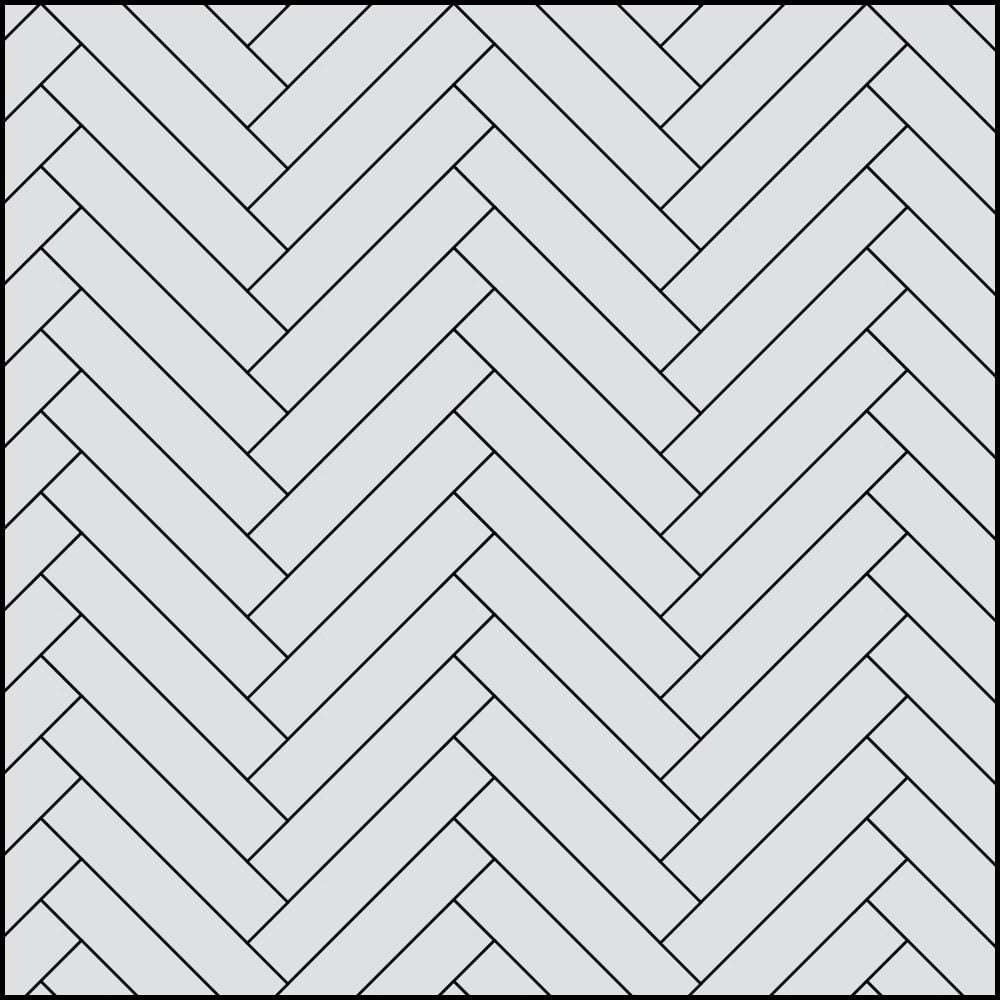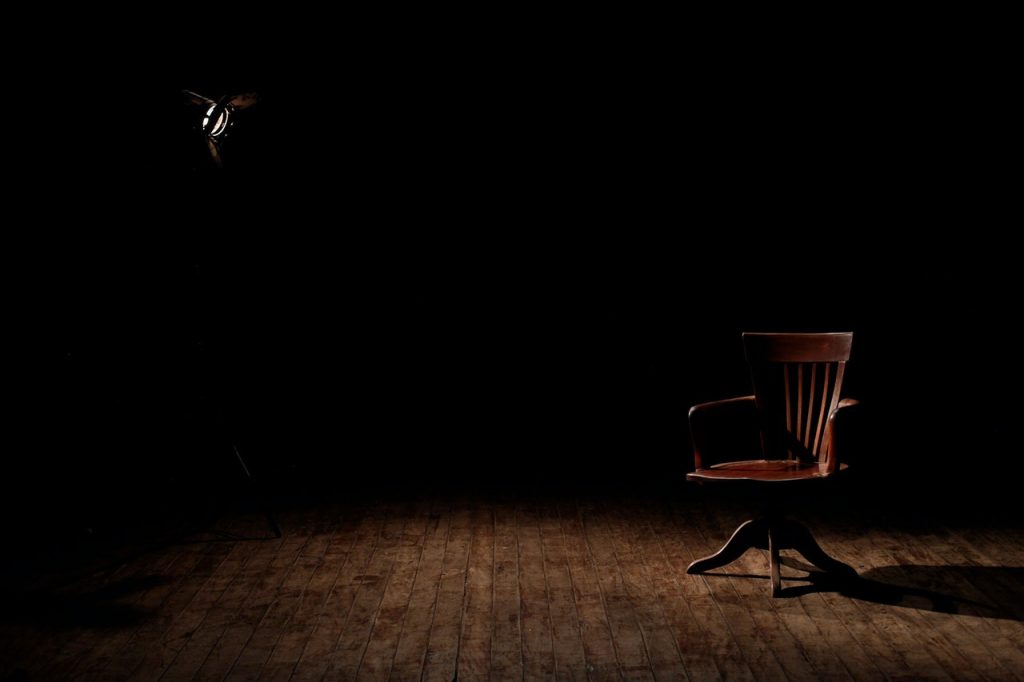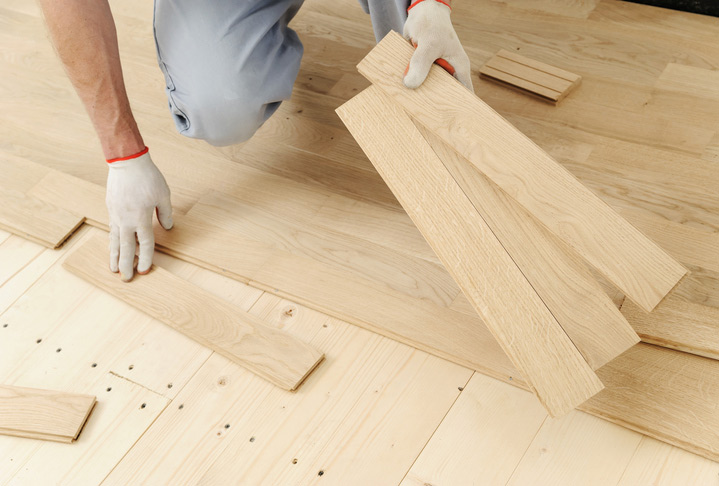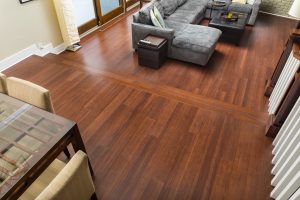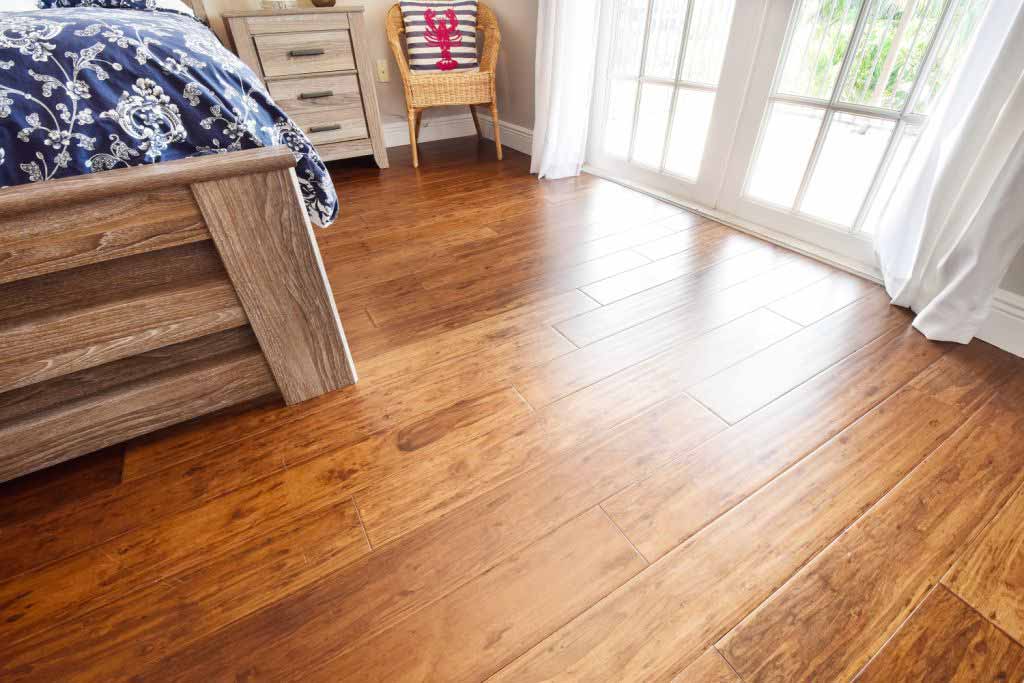Picking an installation pattern for your new flooring can be a hard decision.
There’s a lot to consider: the wood finish, grain pattern, color, and, of course, the install design too. We realize that it can all feel a bit overwhelming. Don’t worry! This guide will help you select the pattern that is best for you.
Bamboo flooring comes in three primary wood grains: vertical, horizontal, and strand woven. This is in addition to the numerous colors and finishes associated with traditional hardwoods. Plus, the direction of the grain matters too.
Perhaps the most common pattern is the random, staggered look that has been the flagship pattern of hardwoods for many years. But new design trends have also cropped up over time. Diagonal and chevron installations are rising in popularity, for example, and each pattern comes with its own specifications.
Furthermore, cost is an important consideration. There are big price differences between plank patterns, finishes, and materials. Of course, the cost also changes depending on the size of your flooring project.
Are you surprised by the number of patterns out there? Having trouble deciding on just one? Look no further: this article provides a digestible yet comprehensive breakdown of various flooring patterns – charms and challenges alike!
Oh, beloved hardwood flooring! How shall I install thee? Let me count the ways.
Do you like our little ode to all the ways you can install wood floors? No, we aren’t referring to glue-down vs. nail-down vs. floating floors installation methods. We’re talking about the incredible variety of hardwood flooring installation patterns.
The install pattern you select will determine how your finished floors look.
Flooring Patterns We Recommend
There are so many different ways to install hardwood floors. We’ve recommended some of our favorites below:
Random Plank Flooring Patterns
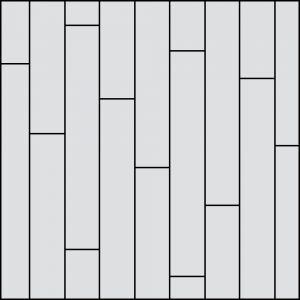
The most common hardwood flooring installation pattern, this design was used by early colonists for their hand-sawed planks.
In this example, the lengths of the planks vary and are placed randomly (yet linearly) on the floor. The starter piece is always cut to a random length. A good installer will also make sure that the seams of the planks are at least 8″ apart.
Liking the random look? Using a wide variety of board widths or a combination of various board widths and lengths will further mix things up.
Diagonal Pattern
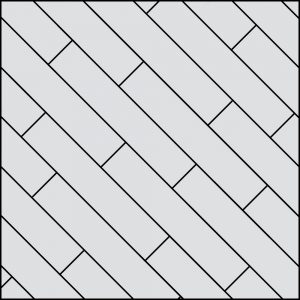
Novice installers would probably automatically lay real wood or engineered hardwood flooring planks parallel to the walls in the room. But maybe it’s time to think outside the box!
Placing them at an angle instead opens a room right up. No matter the wood species or finish, laying the planks diagonally will make any small space look larger.
This type of flooring pattern is also perfect if you want to hide the fact your walls aren’t straight.
The one downside to the diagonal plank pattern is that it requires precise trimming on the part of the installer. But, trust us, this hassle is easily worth it once you see how spectacular diagonals look in your living space!
Chevron Pattern
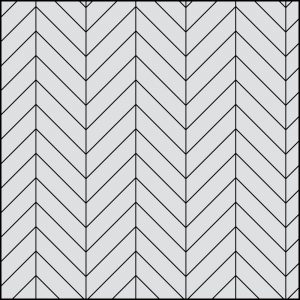
The first chevron wood floors appeared in the homes of wealthy Europeans.
See how the ends of the boards are miter cut at an angle? This creates a v-line that is visually interesting, elegant, and contemporary.
It does cost more to produce and install a chevron pattern. However, it adds drama and flair to all types of floors. Plus, it’s easier than ever to put in your house. Manufacturers have begun to produce planks in this specific shape, requiring a lot less cutting!
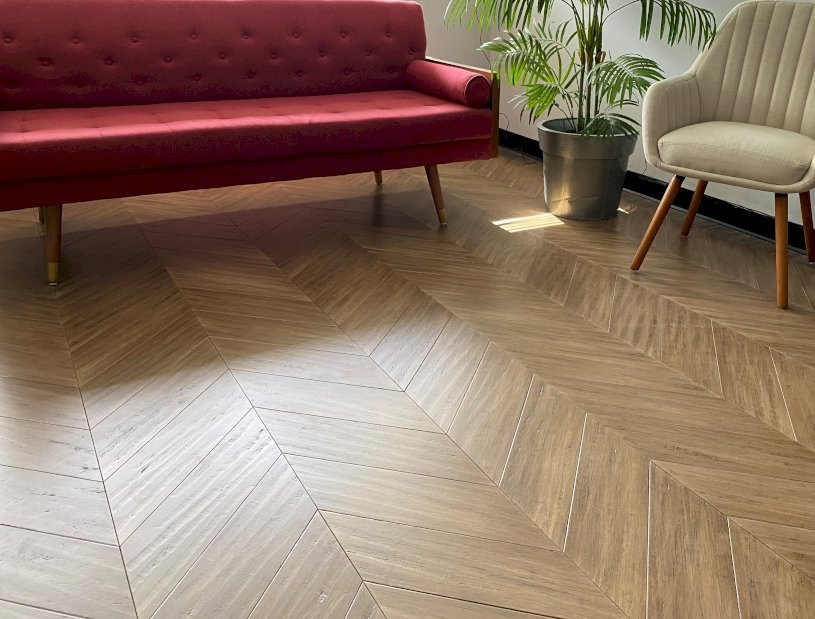
Herringbone Pattern
People frequently assume herringbone and chevron are the same. But this is a mistake! While the two patterns are similar (and thereby easily confused), they simply aren’t identical.
It’s common to see both patterns used for the following floor types:
- tile floors
- solid wood floors
- engineered wood floors
This cute little guy is carefully inspecting the herringbone pattern of the floor. Look closely at where the boards meet. They aren’t mitered but instead overlap.
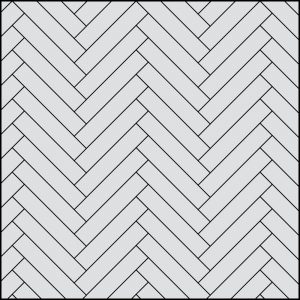
So there you have it. The only difference between herringbone and chevron patterns is the miter cut and how the v-line is created.
You can essentially get the luxurious look of a chevron pattern without the extra cost of cutting each board. All the drama but with a more traditional aesthetic.
Ironically, nowadays chevrons are manufactured in their pattern. They’re no longer cut by installers. But although the herringbone pattern requires more elbow grease, it’s arguably well worth the effort because of how great it looks.
Parquet Pattern
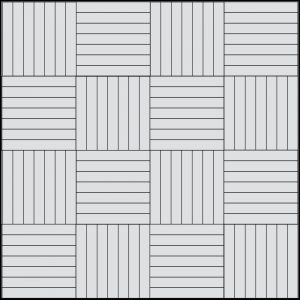
And now a little history lesson about parquet wood floors. Developed in France in the 1500s, the name parquet comes from the French word “parquetry,” which means ‘a small compartment’. Flooring installers take tiny pieces of wood and fit them together to form geometric patterns (‘compartments’).
These individual ‘compartments’ are then laid out in a random or geometric pattern like the basketweave one shown above.
Whichever flooring pattern you choose – a parquet flooring design, herringbone, chevron, diagonal, or random – will certainly enhance your home’s value.
Flooring Patterns We Don’t Recommend
You might occasionally come across flooring patterns in a showroom or magazine that aren’t listed above.
We don’t recommend these patterns because they don’t visually showcase the random natural variation and beauty of solid hardwood flooring. But, in the interest of full disclosure, we’re going to tell you about them too. It’s important to recognize the not-so-good patterns as well as the good ones.
Stair Step Pattern
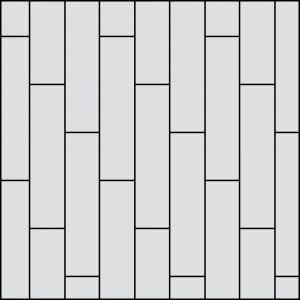
This pattern is also called the lightning bolt pattern. That’s because the board lines are installed to create a stair or zigzag pattern.
The installer creates this pattern by installing the first run end-to-end. Then, the next four runs start with boards cut smaller than the previous run.
Installers sometimes do this so they can pre-cut stacks of planks to the same length. Then they can rack and install them much faster. (More on racking later.)
When you use a stair-step pattern, you place seams at regular intervals, not randomly.
H Pattern
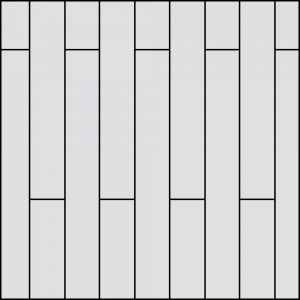
Another pattern we don’t typically recommend is the H-pattern.
As durable as any of the others, many find it tacky. While a neat, orderly pattern sounds appealing, it isn’t nearly as charming when implemented.
Yes, traditions exist to be challenged. But the tendency for hardwood installers to randomize plank patterns is a tried-and-true method.
Sorry to be blunt, but in our opinion, there’s just no redeeming aesthetic quality about the H-pattern.
Picking Your Flooring Pattern
So which pattern speaks to you? Naturally, this decision is very personal. Ultimately, the flooring pattern you pick should support the overall interior style of your home. Here are a few things to keep in mind about each pattern:
Random
A colonial-inspired look.
- Lowest installation cost.
- Least amount of waste.
- Good for open spaces and rectangular rooms.
- Most commonly lacks the element of uniqueness.
- Order 10% extra for cutting and waste.
Diagonal
A 45° twist on the random pattern.
- Makes small spaces appear larger.
- Good for non-rectangular rooms.
- Higher installation cost.
- Non-traditional, unique pattern.
- Requires ordering 15% extra for cutting and waste
FYI: The rule of thumb for most plank floors is to order 10% extra for cutting and waste.
Chevron
An elegant European style.
- Dramatic visual appeal
- Higher installation cost
- Not well suited for adjoining rooms.
- Non-traditional, unique pattern.
Herringbone
Similar to chevron – yet different.
- Dramatic visual appeal.
- Higher installation cost.
- Can cost less to install than the chevron pattern.
- Doesn’t work well in small rooms.
Parquet
Highly ornate and special.
- Unique and dramatic visual appeal.
- Can be expensive to install, depending on the pattern.
- Parquet tiles may not wear well.
- Certain patterns may make the home harder to sell.
Racking Up for Results
If you’re not a professional wood floor installer, you probably have no idea what the term ‘racking’ means. No worries; it’s easy to understand.
Racking simply refers to the installer laying out the floor in advance to see what it will look like once installed.
If you plan to install your own floors, don’t skip racking if you want the best results.
Fun Fact: Racking sure has a lot of different meanings. There’s being “racked with guilt,” “racking one’s shoes,” and “racking off the wine” (drawing it from the sediment in the barrel), to name just a few. Only in certain instances does racking refer to flooring installations!
Because wood is a natural product, there are always variations. Racking allows you to see and arrange the planks in a manner most pleasing to the eye.
Racking also ensures that plank sizes are distributed evenly. No one wants to get to the end of an installation to find out they only have short pieces left!
Finally, racking gives you a good idea of how the finished floor will appear. It exposes any potential problems with installation and also speeds up the installation process.
Strips or Planks?
Wood flooring is available in strips or planks. To put it simply: strips are narrow, and planks are wide.
Generally, strips are between 1 1/2 inches to 2 1/4 inches wide. They are made from smaller parts of the tree and contain less heartwood. Planks are anywhere from 3 to 8 inches wide. They come from larger parts of the tree, are denser, and contain more heartwood.
What is heartwood? Heartwood is located at the center of the tree (like one’s heart!) It tends to be harder, darker, and more resistant to decay than other parts of the tree.
With a random or diagonal pattern, you can mix strips with planks to further increase the “randomness.” Because strips generally cost less than planks, this may save money too.
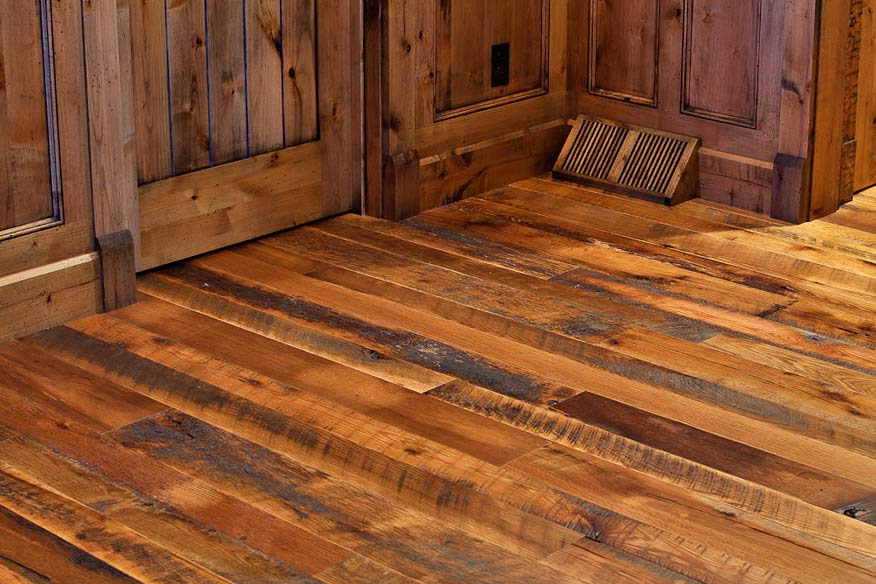
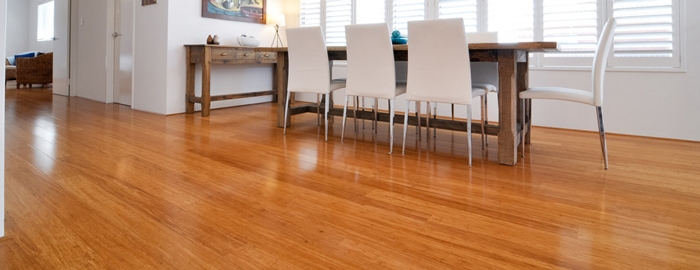
A Brief History of Flooring Patterns
Let’s quickly explore the history of flooring patterns in the United States.
The colonists who first arrived in America were blessed with lots of trees. Converting those trees into lumber and then into flooring planks wasn’t easy work, however.
Good thing those colonists were tough. They employed a technique called pit-sawing and used lots of arm muscle to turn felled trees into flooring. Here’s a couple of men recreating this process.
Fun Fact: Pit-sawing was generally conducted in a saw pit (a huge hole dug into the earth). One man would stand above the log and one below so they could saw together in unison. Saw pits had to be covered when not in use so they wouldn’t fill with water.
Hearing all this, aren’t you glad you can just pick up the phone and order the finished material for your floors? No saw pit work for you!
Evolution of Floor Finishes and Patterns
In the beginning, those pit-sawed planks were nailed down in random lengths. Years of use and scrubbing would eventually create a smooth surface.
In the 1800s, people started stenciling their wood floors with borders or rug-like patterns. This was quite stylish until rugs appeared on the scene.
Patterned and floral rugs and carpets were all the rage until the 1870s. Eventually, people returned to their senses and began favoring wood again.
Taking a Hint
In 1872, Charles Eastlake published his Hints on Household Taste in Furniture, Upholstery, and Other Details, which advocated for hardwoods. He made parquet (see below) and borders popular. Wood floors became quite ornate.
As you can see from the cover of this 1895 catalog, these upper-class flooring patterns became very intricate. They stayed that way through the beginning of the 20th century.
For the middle and upper-middle classes, however, plain planks would do. Good flooring was made of oak or other hardwood. The not-so-good flooring was pine. Shellac and varnish remained the most popular finishes.
The Advent of Carpet
Through the beginning of the 21st century, wood flooring was popular and common, even though it remained pricey.
But by the end of World War II, carpet was cheap. Wood flooring companies tried to compete on price by reducing quality. Installers rushed laying floors to cut costs even more. Between the two of them, they all but destroyed the reputation of wood as a durable, quality flooring.
Rebirth of a Classic
The 1980s saw the return of authentic, classic, and clean societal trends. This return to conservative staples like polo shirts for men and shift dresses for women spilled over into home decor. Suddenly the rustic yet contemporary look of wood flooring was in, and the prefinished version was hot. Parquet wasn’t invited to the party, but plank flooring had definitely made a comeback.
Fun Fact: A shift dress hangs loosely from one’s shoulders. They came about in the 1920s as a pushback to stiff Edwardian attire. Shift dresses get their name from the fact that women can easily “shift” about in them.
In the early days of the rebirth, the finish choices were limited. So designers, homeowners, and installers got creative with installation patterns. Patterns borrowed from fabric and tile made their way to wood surface products.
Today the installation pattern is just as important as the product you select in determining the finished look.
5 Things to Remember about Flooring Patterns
Wood floors are not merely a flooring purchase. They are a long-lasting investment in your home. They will provide years of beauty and service.
Pick the installation pattern of your floors as carefully as you pick the flooring and the installer. Keep in mind:
- If the subfloor on the joists is sagging, lay floors at right angles to the floor joists for strength.
- With open floor plans, keep the line of sight in mind when picking a pattern.
- Laying floors parallel to the longest wall makes a room look larger.
- Diagonal floors are not always at 45° angles.
- Always acclimate the floor in advance and read the installation guide. This will save you from making common installation errors.
Last Updated: 5/17/23
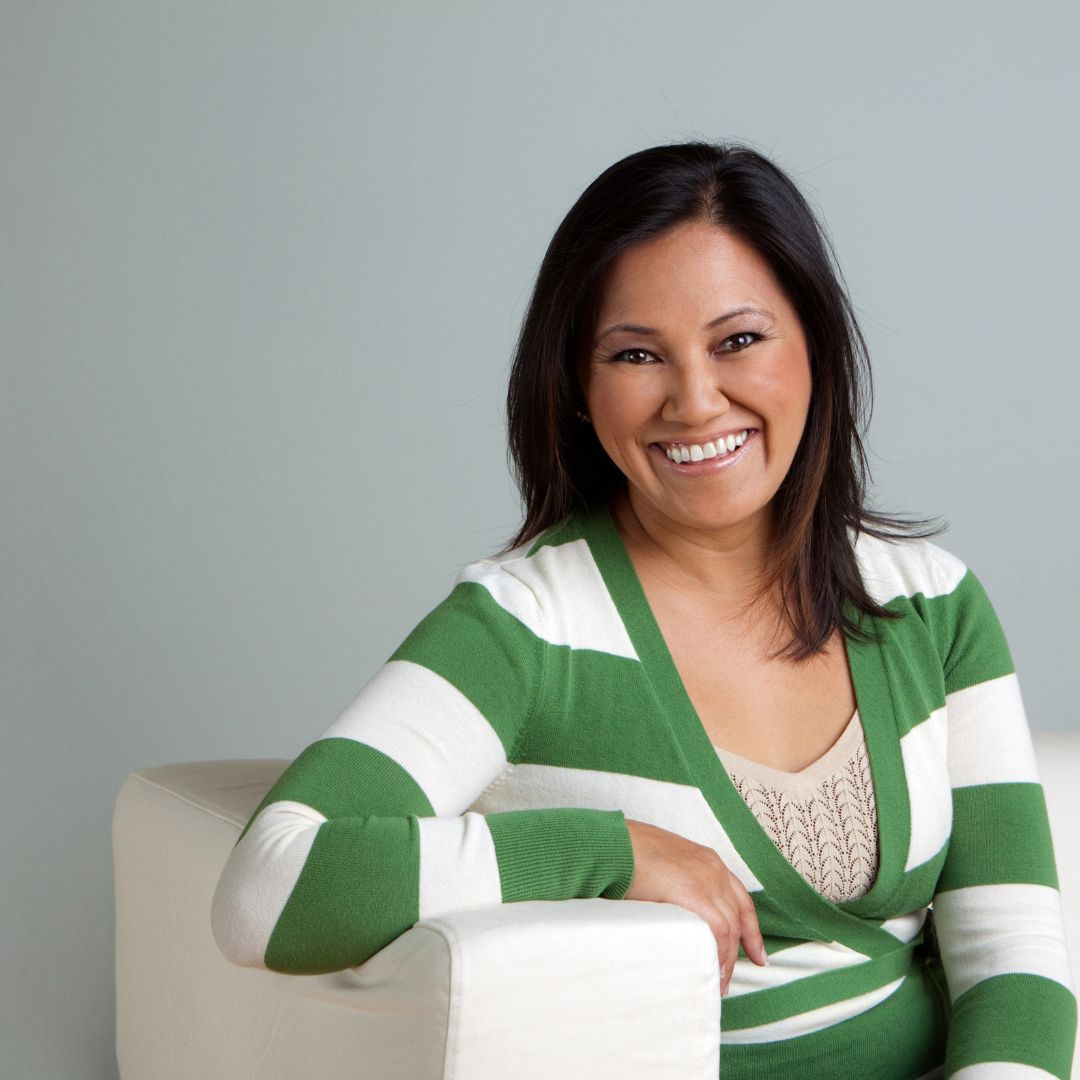
About the Author
Cheryl is our go-to guru for all things sustainable living. She’s on a mission to make your family and our planet thrive! With a heart as big as her passion for sustainability, Cheryl brings you the freshest insights on eco-friendly building products and energy efficiency. 🌱💡
And hey, did you hear about the eco-friendly lightbulb that went to therapy? It finally found its inner “enlightenment”! 😄 Join Cheryl on this green journey, where she’ll tackle your concerns with a smile and a sprinkle of eco-humor!

